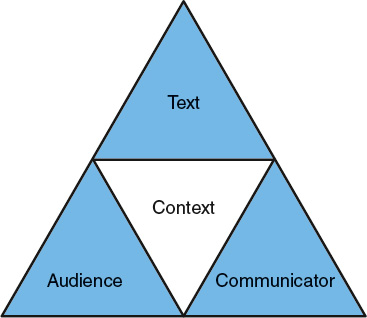5b Make good choices for your rhetorical situation.
A rhetorical situation is the full set of circumstances surrounding any communication. When you communicate, whether you’re posting on a social networking site, creating a video, or writing an essay for your psychology class, you need to consider and make careful choices about all the elements of your situation.

The rhetorical situation is often depicted as a triangle to present the idea that three important elements are closely connected—your text, including your topic and the message you want to convey (5c); your role as the communicator, including your purpose and your stance, or attitude toward the text (5d); and your audience (5e). If all the pieces making up the larger triangle don’t work together, the communication will not be effective. But important as these elements are, they are connected to a context that shapes all the angles of the triangle. Considering context fully requires you to consider many other questions about the rhetorical situation, such as what kind of text you should create and what conventions you should follow to meet audience expectations for creating and delivering the text (5f).
Informal and formal rhetorical situations
Most people are accustomed to writing in some rhetorical situations without analyzing them closely. When you post something on a friend’s social networking page, for example, you probably spend little time pondering what your friend values or finds funny, how to phrase your words, which links or photos would best emphasize your point, or why you’re taking the time to post. However, academic and other formal rhetorical situations may seem less familiar than the social writing you share with friends. Until you understand clearly what such situations demand of you, allow extra time to analyze the overall context, the topic and message, the purpose and stance, the audience, and other elements carefully.